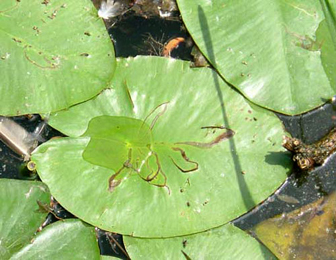|
||||||
|
Hydromyza
livens (Fabricius, 1794) Musca
livens Fabricius, 1794. Entom. Syst. 4: 345 |
||||||||||||||||||||||||||||||||||||||||||||||||||||||||||||||||||||
Leaf-miner: Mines visible from a distance as long, elegant corridors in the leaf upper-surface, often several in a leaf. The corridors run towards to insertion of the the underwater petiole. From this point the larvae descend as borers into the petiole and finally pupate there. A part of the pupariria is thin-walled and emerges in August. The other pupariria are thick-walled; they hibernate in the petiole and rise the the surface next spring, after the petiole has rotted away (Hering, 1947a). Ovipostion at the underside of the leaf, at some distance from the leaf margin. Mines visible from a distance as long, elegant corridors in the leaf upper-surface, often several in a leaf. The corridors run towwards to insertion of the the underwater petiole. From this point the larvae descend as borers into the petiole, and finally pupate there. A part of the pupae is thin-walled, and emerge alreay in August. The other pupae are thick-walled; they hibernate in the petiole and rise the the surface next spring, after the petiole has rotted away (de Meijere, 1895a; Hering, 1957a; Brock & van der Velde, 1987a) Bladmineerders van Europa.
Larva: The larvae of flies are leg-less maggots without a head capsule (see examples). They never have thoracic or abdominal legs. They do not have chewing mouthparts, although they do have a characteristic cephalo-pharyngeal skeleton (see examples), usually visible internally through the body wall. Puparium: The puparia of flies are formed within the hardened last larval skin or puparium and as a result sheaths enclosing head appendages, wings and legs are not visible externally (see examples). Some of the puparium is thin-walled and emerges in August. Others are thick-walled; they hibernate in the petiole and rise the the surface next spring, after the petiole has rotted away (Hering, 1947a). Comments: Stubbs in Chandler (1978) did not indicate whether his host records were British or Foreign and are therefore tentatively included under 'Hosts in Britain' and 'Hosts elsewhere'. Hosts in Great Britain and Ireland:
Hosts elsewhere:
Time of year - mines: August. Time of year - adults: Currently unknown. Distribution in Great Britain and Ireland: Widespread in England including Warwickshire (Bedworth and Longford) (Robbins, 1991: 28), Bedfordshire, Cambridgeshire, Durham, East Gloucestershire, East Norfolk, Huntingdonshire, Northamptonshire, Shropshire, South Hampshire, South Lancashire, South Lincolnshire, Surrey and West Gloucestershire (NBN Atlas). Distribution elsewhere: Widespread in continental Europe including Denmark (Fabricius, 1794), The Netherlands (Bladmineerders van Europa), Belgium (Gosseries, 1991b), Austria, Czech Republic, Estonia, Finland, French mainland, Germany, Hungary, Lithuania, Norwegian mainland, Poland, Russia - North, Sweden and Switzerland (de Jong in Fauna Europaea). NBN Atlas links to known host species:
British and Irish Parasitoids in Britain and elsewhere: Currently unknown. |
|
|
|
| External links: | Search the internet: |
| Biodiversity Heritage Library Bladmineerders van Europa British leafminers Encyclopedia of Life Fauna Europaea NBN Atlas NHM UK Checklist |
Find
using Google Find using Google Scholar Find images using Google |
| Last updated 04-Dec-2017 Brian Pitkin | ||

